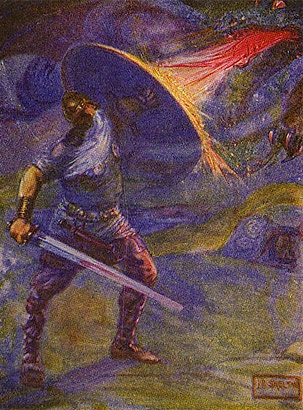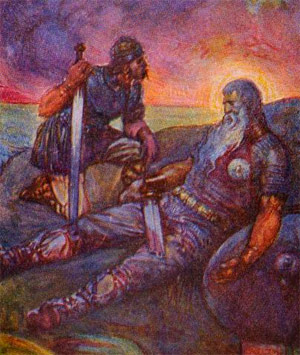Beowulf:
BASIC FACTS:

Title: Beowulf.
Author: Anonymous.
Date of composition: The oral version of the poem was composed in the 8th century.
Date of publication: Written manuscript in Old English in the 10-11th centuries.
Setting(s): 5th century Scandinavia (Denmark and Geatland).
Language/dialect: Dialect of Mercia into West Saxon.
Genre: Old English heroic epic poem.
Type of narrator: A Christian narrator telling a story of pagan times (omniscient narrator).
Plot summary: Beowulf, the hero of the Geats, goes to help Hrothgar, the king of the Danes, because his great hall, Heorot, is being attacked by the monster Grendel. Beowulf kills Grendel without any weapons and then Grendel´s mother fights with Beowulf because she wants to get revenge for her son.
Later in his life, Beowulf becomes the King of the Geats. Beowulf finds his dominion terrorised by a dragon whose treasure has been stolen from his cave. He attacks the dragon with his comrades but they fail. Then, Beowulf decides to follow the dragon into his cave but only Wiglaf joins him. Finally, Beowulf kills the dragon, but he is mortally wounded.
FURTHER INFORMATION:
Major themes:
The Good vs Evil
Beowulf is an excellent example of the typical epic poem. The hero represents Good, he is brave, able and willing to fight everything that challenges the peace of the characters. The role of Evil is played by ogres, dragons, etc., who represent the chaos that endangers the original tranquillity of the story.
Identity
In Anglo-Saxon times, people were supposed to introduce themselves every time they met a new person. One's identity was constituted by their ancestors, achievements and purpose in life. Warriors especially were expected to boast about their past victories, so that people knew how to treat them. This epic is based on the tradition and principles of loyal warriors.
Strength
It is a constant theme in Beowulf, as warriors are always proving their strength by running or riding long distances. After their strength has been proven, these heroes seem more likely to kill or defeat any enemy. A warrior's strength seems more important than their skills in this epic. His courageous attitude towards death, and indifference towards the consequences that may affect him if he dies, are what make him braver than others.
Religion
As a story based in late medieval Anglo-Saxon times, we might expect the poem to include solely pagan references, but we can also find some Christian influences in the epic, such as the reference to the Old Testament story of Cain and Abel.
Violence and Mortality
In the Scandinavian tradition, the theme of mortality is a constant and violence is linked to it. The author reminds us almost in every line that the fate of every character is the same: death. However, this death is not something peaceful or pleasant. The process of dying is exaggerated and the descriptions made are extremely gory.
Supernatural images
In the epic, the hero must fight against ogres, demons, dragons and strange monsters in the lake. Supernatural images are present in almost every part of the story, even in flashback scenes of fights of the past, in which strange creatures are killed by Beowulf. These monsters are always linked to the evil, and sometimes have with a biblical sense.
Main Characters:

Beowulf: He is the protagonist of the epic with the same name. He is the nephew of the Swedish king Hygelac and he will finally be the heir and king of this land. As the hero, he will help the king of the Danes. Beowulf fights against Grendel, Grendel's mother and the fire-breathing dragon, proving to be the strongest and best warrior of the time.
Grendel: A terrible ogre who lives in a cavern near to Heorot with his mother. His attack on the Mead Hall provokes Beowulf to kill him.
Secondary characters:
Grendel’s Mother: She is an ogre who takes revenge for the death of her son, Grendel. She attacks the Mead-Hall to avenge Grendel. In the cavern, Beowulf fights against and defeats her.
Hrothgar: The King of the Danes who calls Beowulf for help because the Mead-Hall is under the attack of Grendel.
Wiglaf: After the attack of the dragon, he will be the only warrior to follow and help the old Beowulf to fight the fire-breathing dragon. Beowulf declares him as his successor as the next King of Geatland.
Other characters:
http://csis.pace.edu/grendel/proj1b/names.html
Symbols:
Grendel’s head: It symbolises the victory or power of the Geats and Danes. It could also symbolise proof that Grendel is dead (man’s prize: wergild).
Mead-Hall: It is the symbol of a society, it was a communal place where warriors gathered to drink mead and celebrate victories. The community met here to hear ancient epic tales told by Scops. In literature, the Mead-Hall symbolises safety, fellowship, and all that is good in humanity.
Golden torque: It is a necklace and a symbol of the transferral of power from the Danes to the Geats. A symbol of loyalty.
Swamplands: The complete opposite of the Mead-Hall, it symbolises the stagnant water that drives to desolation and destruction.
Banquet: A symbol of joy and mirth.
Literary devices:

Old English poetry has no stanzic form and no rhyme except by accident; there is no set number of syllables per line. In Beowulf, a normal line contains between eight and twelve syllables.
The most important literary devices used in Beowulf are alliteration (the repetition of the first letter or sound in a group of words), metaphors, hyperboles and kennings (a type of literary trope, in the form of a compound that employs figurative language in place of a more concrete single-word noun).
Examples:
ALLITERATION
Alone by the lake
Forlornly he stands,
Waits wonderingly.
METAPHOR
“There came gliding in the black night the walker in darkness. The warriors slept who should hold the horned house- all but one.”
HYPERBOLES
“Over all the world, or between the seas, / Or under the heaven, no hero was greater.” (671-672). Exaggeration is used to convince us of how great Beowulf is.
“The head of Grendel, with heavy toil; / Four of the stoutest, with all their strength, / Could hardly carry on swaying spear / Grendel's head to the gold-decked hall.” (1109-1112) Exaggerations are made concerning the size and weight of the monster’s head.
KENNINGS
For “sea”: “sail-road” (Beowulf 1429 b), “swan-road” (Beowulf 200 a) and “whale-road” (Beowulf 10).



